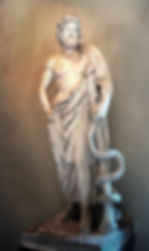"A Song of Ice and Fire", "Harry Potter" and the Appeal of an Undead Villain
- Dino Mušić
- Sep 25, 2022
- 6 min read
To call a narrative element appealing is, naturally, a speculative act for one cannot even hope to analyze all of the possible reactions to a particular element of any given narrative. However, certain through lines and parallels can be noticed even if one does not conduct extensive, in-depth research. Using two immensely popular and successful series as examples, this article will discuss how each of them construct its respective undead villain(s) and what similarities, if any, exist between them.

“Undead” signifies something that exists in a liminal space between life and death, something that is neither entirely dead nor entirely alive. The most notable example is perhaps a zombie which is, generally speaking, a corpse capable of movement and action, but ridden of mental capacities a human would have. However, the first “modern” usage of the term was not related to a zombie-like creature; the popularization of the term ought to be ascribed to Bram Stoker in his Dracula (1897) where the term was basically treated as synonymous with vampires:
Before we do anything, let me tell you this; it is out of the lore and experience of the ancients and of all those who have studied the powers of the Un-Dead. When they become such, there comes with the change the curse of immortality; they cannot die, but must go on age after age adding new victims and multiplying the evils of the world; for all that die from the preying of the Un-Dead becomes themselves Un-Dead, and prey on their kind. And so the circle goes on ever widening, like as the ripples from a stone thrown in the water (200).

This is not to say that undead beings were brought about by Stoker’s writing. For example, Shelley’s Frankenstein (1818) most definitely features an undead monster, but it was simply not labeled as such. It goes without saying that undead creatures have existed in common imagination for a very long time. One can find examples in vrykolakas, undead vampiric monsters of Greek folklore—people who lived sacrilegious lives or were excommunicated were believed to come back as vrykolakas (Summers, 1929, ch. 1, para. 57-59). Also, Greek mythology itself bears some evidence to the undead phenomenon where, according to some sources, Asclepius, a “mortal healer who was able to raise the dead”, utilized his abilities so much that “Hades lodged a complaint with Zeus” (Hansen, 2004, 120).
The motif of “undeath” has proliferated in modern fantasy fiction to the point where it would be difficult, nigh impossible even, to enumerate all pieces of fiction where it is prominently featured. Yet, despite its popularity, the motif itself is broad enough to where it can be molded to fit many different narratives and narrative roles. In an effort to elaborate on this point further, two radically different fantasy texts will be considered: George R. R. Martin’s A Song of Ice and Fire (ASOIAF) and J. K. Rowling’s Harry Potter (HP).
ASOIAF is a series of fantasy novels further popularized via a TV adaptation titled Game of Thrones (GOT). The onus of the narrative is placed on nine noble houses that are, through various alliances, waring for supremacy and rule over a fictional land called Westeros. While humans are entirely subsumed by the desire to sit on the iron throne, a threat is rising in the frozen wastelands of the north. Undead creatures known as the White Walkers led by the Night King are slowly amassing an army and marching against the living, regardless of their house or their allegiance. This creates an interesting juxtaposition, where the struggle for the throne is shown to be futile; without mankind’s unity, the great enemy in the north will conquer all.

The same need for unification and recognition of a larger, common enemy could have been achieved with a myriad different fantasy creatures, but George R. R. Martin chose the undead. While his reasoning may differ, it can be argued that there exists a single underlying explanation as to why the undead function so well within his world.
Martin’s series is a grimdark one, which means that the focus is on gritty realism and a bleak world where every action bears some sort of consequence. At this point in time, the series is well-known as one where any character can die at any point, evidenced by the fact that Eddard Stark, a supposed protagonist, does not make it out of the first book. There exist only two cases of resurrection, both involving strange magic that is yet to receive an explanation; the series remains unfinished as of the writing of this article, therefore, it remains to be seen what Martin does with resurrected characters. However, regardless of the outcome, the following point should still stand.

For a grim world where the ultimate consequence is death, there exists no force more frightening than one unsubjectable to such fate. What is more, the law of death that humanity cannot escape is not the only one that the undead need not conform to. The politics, the manipulations, the threats and deceits: none of that is of aid against an enemy tied to reality only by long forgotten, ancient magic. The large draw of the series as a whole is how well the political games were handled and written; characters rose to prominence because they could manipulate those around them. The enemy in the north is the perfect antithesis to such skills, none of which can be used to defeat them.
There exist few villains as iconic as J. K. Rowling’s Lord Voldemort; yet, when analyzing the books to uncover what makes him so iconic, it is difficult to distil a convincing conclusion. For the majority of the story, he simply functions as the evil that Harry and his friends need to defeat; even though the series does offer some backstory to his character, one never feels any sort of sympathy for his malignant nature. It can, of course, be argued that Voldemort rose to iconic status by proxy because the entirety of Rowling’s fictional world was so enchanting, magical, and successful at capturing the minds of readers worldwide—it affected an entire generation of youth and has become a household name.

The world of HP is filled with whimsy, magic, humor, friendship, life—apart from the final novel, the fictional society depicted by Rowling is basically the flip side of Martin’s Westeros. An often criticized aspect of HP as a series is that, in a world filled with wondrous magic, there exists a killing curse that nullifies all magical creativity—evil characters use it almost exclusively. The same is the case with Voldemort who, despite himself being a library of magical knowledge, tends to rely on the killing curse.

Voldemort achieves immortality by splitting his soul into seven pieces, resembling fabled fictional scholars such as Dracula, Dr. Jekyll and Frankenstein (Granger, 2009, 45) and this can already be considered as him becoming undead. But, if one must first die to become undead, that is also achieved when the killing curse he casts on infant Harry rebounds. He essentially kills himself with his own spell, but his horcruxes (the objects/beings into which he stored the pieces of his soul) keep him alive. Yet, for all intents and purposes, he was hit by the killing curse and he did die. This liminality of his being functions perfectly to paint his villainous image within the world that is otherwise filled with colorful magic.
Comparing the two undead villainous figures, one can observe that their being distanced from life makes them almost synonymous with death. Painted in broad strokes without deep characterization, they manage to capture readers’ imaginations because of how well they fulfill their roles within their respective narratives. The Night King brings punishment and death to all the characters of ASOIAF because the world was already constructed as one where actions have consequences—few, if any of the main characters within the story are purely good, and all are looking to gain an advantage in the game of thrones. Voldemort, on the other hand, is the sum of vileness, corruption, and pride: he is the antithesis of everything the readers love about Hogwarts and the wizarding world. Therefore, his villainy affects the audience profoundly because he seeks to destroy that balance between the human and the magical that is so alluring.

The undead “connect the seen and the invisible, the known and the unknown, the understood and the unexplained, the private and the public, mystery and science” (Hermann, 2014, 328). They thus remain forever constructed as beings standing on the razor sharp edge of life; their power and frightening aura stems from their unknowability and the impossibility of discerning their motivations. Both the Night King and Voldemort have a desire to destroy, yet it is not extensively motivated. However, that lack of provided motivation is precisely what makes them so terrifying for the characters within their respective stories.
While not being an extensive analysis, this article discussed undead figures in two tonally very different fantasy narratives. Similarities between the two were showcased in an effort to present how analogous their functions are, despite the fact that their respective narratives are so different. The appeal of the topic of death and of undead creatures is certainly not lessening and one can expect to read about many more such thematic explorations in the future of the fantasy genre—given the proper setup, some of them just might become as iconic as the dark lord of the wizarding world.
Bibliographical References
Granger, J. (2009) Harry Potter’s Bookshelf: The Great Books behind the Hogwarts Adventures. Penguin press.
Hansen, W. (2004). Handbook of classical mythology. ABC Clio.
Herrmann, A. F. (2014). Ghosts, Vampires, Zombies, and Us: The Undead as Autoethnographic Bridges. International Review of Qualitative Research, 7(3), 327–341. https://doi.org/10.1525/irqr.2014.7.3.327
Stojilkov, A. (2015). Life(and)death in “Harry Potter”: The Immortality of Love and Soul. Mosaic: An Interdisciplinary Critical Journal, 48(2), 133–148. http://www.jstor.org/stable/44030425
Stoker, B. (1897). Dracula. Grosset & Dunlap.
Visual Sources
Cover figure: Warner Bros. (2011). HP and the Deathly Hallows; Voldemort casting the killing curse. [Movie Still]. Fantasy Topics. Retrieved from: https://fantasytopics.com/lord-voldemort-character-analysis/
Figure 1: AMC Networks. (2022). The Walking Dead; The show that revitalized the interest in zombies. [TV Series Still]. Variety. Retrieved from: https://variety.com/2022/tv/news/tales-of-the-walking-dead-crew-member-accident-1235226490/
Figure 2. Menhert, M. F. (2008). Statue of Asclepius. [Photography]. Wikipedia. Retrieved from: https://en.wikipedia.org/wiki/File:Asklepios_-_Epidauros.jpg
Figure 3. HBO. (n.d.). Game of Thrones; The Night King. [TV Series Still]. Wallpaper Abyss. Retrieved from: https://wall.alphacoders.com/tag/night-king-(game-of-thrones)-wallpapers
Figure 4. Warner Bros. (2011). HP and the Deathly Hallows; Voldemort enraged. [Movie Still]. Wallpaperbetter. Retrieved from: https://www.wallpaperbetter.com/en/hd-wallpaper-akcdu/download/1920x1080
Figure 5. Anonymous. (n.d.). The six deliberate horcruxes made by Voldemort. [Collage of Movie Stills]. Harry Potter Fan Zone. Retrieved from: https://www.harrypotterfanzone.com/horcruxes/
Figure 6. Anonymous. (n.d.). The Four Houses of Hogwarts. [Illustration]. 34th Street. Retrieved from: https://www.34st.com/article/2016/12/highbrows-guide-to-hogwarts-houses
Figure 7. Calou, O. (2020). Houses of Westeros. [Illustration]. Art Station. Retrieved from: https://www.artstation.com/artwork/L3gBn0






